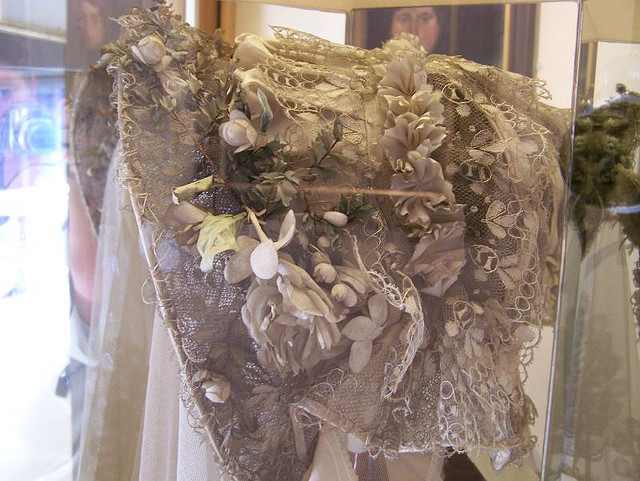Clothing very often holds a privileged position within house-museums dedicated to women writers. Charlotte Brontë’s old bedroom includes two glass cases containing clothing either ‘worn by’ or ‘carried by’ Charlotte, as the captions point out. One cabinet, positioned in the centre of the room, consists of a dress draped with a shawl, a half-folded parasol, a pair of stockings, a pair of gloves, and a fan. In a separate case, located against the bedroom wall, is all that remains of Charlotte Brontë’s wedding outfit: the wedding-bonnet and veil. In this, she married the Reverend Arthur Bell Nicholls in Haworth parish church on June 29, 1854. Brontë’s first biographer, Elizabeth Gaskell, noted that locals described her as looking ‘like a snowdrop,’ in her white muslin dress topped off with this pale green-trimmed bonnet and white lace veil. The famously quiet wedding was followed by an unexpectedly happy marriage which was cut short by the bride’s death from complications associated with her pregnancy. Faded and partially dismantled though it is, displayed in the bedroom in which she died on 31 March 1855, the wedding outfit is nowadays – and has been for some considerable time — one of the most celebrated items in the collections of the Haworth Parsonage Museum.
Along with the bonnet and veil, Brontë’s lost wedding dress also finds representation in Charlotte’s room. The white dress on show is a replica of the original sold by Arthur Bell Nicholls’ second wife at auction after his death. The dress works not just to construct Brontë as a woman, but to insert her into the narratives and counter-narratives of her novels Jane Eyre and Villette – ‘Reader, I married him’ and ‘Reader, I did not marry him’ respectively. It performs her escape from daughterhood, sisterhood and spinsterhood into the status of achieving ‘a home of her own’ like her heroine Jane Eyre, while also describing a justified anxiety about the dangers of marriage, much like that experienced by the heroine of Villette – Lucy Snowe.
Brontë’s clothing has long carried a powerful charge. Virginia Woolf, for example, responded emotionally to the dead woman’s personal possessions displayed then in the adjunct Brontë Museum, publishing this unsigned account under the title ‘Haworth, November 1904’ in The Guardian on 21st December:
The museum is certainly rather a pallid and inanimate collection of objects. …Here are many autograph letters, pencil drawings, and other documents. But the most touching case – so touching that one hardly feels reverent in one’s gaze – is that which contains the little personal relics of the dead woman. The natural fate of such things is to die before the body that wore them, and because these, trifling and transient though they are, have survived, Charlotte Brontë the woman comes to life, and one forgets the chiefly memorable fact that she was a great writer. Her shoes and her thin muslin dress have outlived her.
Woolf would not have seen the wedding bonnet, since the parsonage at Haworth did not acquire it until 1954. Nonetheless, the language of wedding seems to permeate Woolf’s prose; the snow-bound landscape is likened to ‘a vast wedding cake’ and ‘the earth was bridal in its virgin snow’. The foregrounding of this language of wedding follows from the way that Woolf effectively describes Haworth as the site of a struggle between conceiving Brontë as a writer and Brontë as a woman. While the writing seems dead, ‘pallid’ and ‘inanimate’, the shoes and dress have ‘outlived’ the writer, remaining uncomfortably alive and able to bring the dead woman back to an uneasy and imperfect life, albeit in a latter-day glass coffin. Woolf is essentially troubled by a sense of disrespectful snooping. For her, the encounter with Brontë’s personal items overshadows what it is that the museum ought to be memorialising: – ‘the chiefly memorable fact that [Charlotte] was a great writer.’ Luckily, a simple reading of any one of Charlotte’s publications makes it impossible to forget that this is the case.
Also on Charlotte Brontë see https://www.open.ac.uk/blogs/literarytourist/?p=202 and https://www.open.ac.uk/blogs/literarytourist/?p=195 and https://www.open.ac.uk/blogs/literarytourist/?p=136

